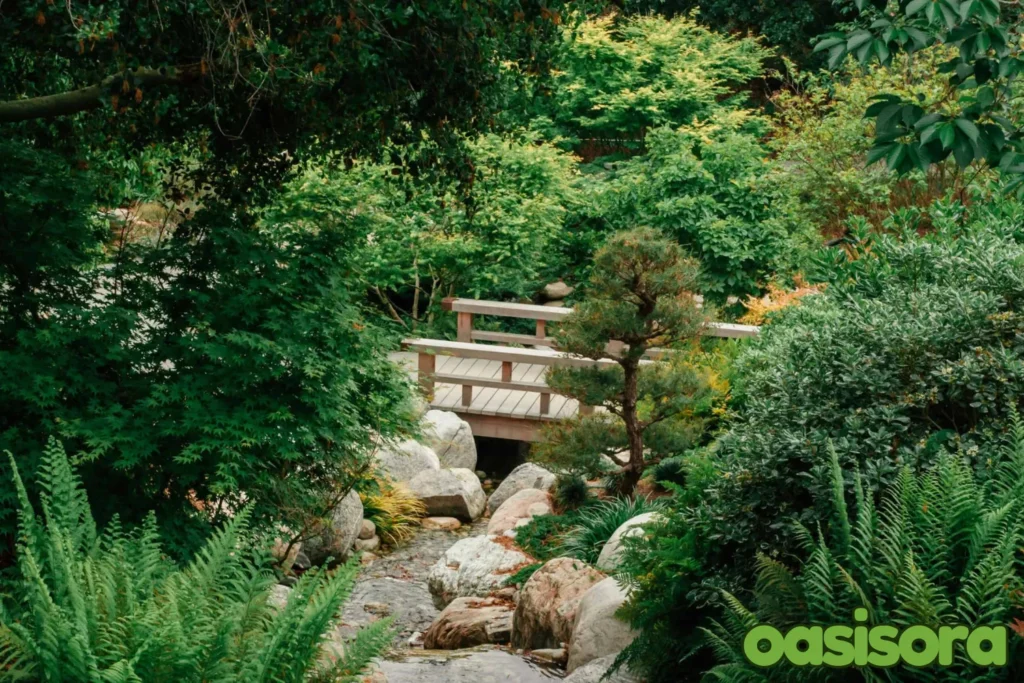
The Japanese gardens are renowned for their serene beauty and symbolic significance. This is due to their rare and beautiful plants that captivate attention. Plus, for centuries, these plants have played a vital role in Japanese culture. They represent harmony, peacefulness, and the connection between nature and human life. However, creating a Japanese-style garden at home can be confusing. But fret not!
In this blog post, we will discover important information about 25 popular breathtaking Japanese Plants in gardens around the world!. Moreover, we will share key details such as hardiness zones, soil requirements, and sun exposure needs of each of these. Let’s get started.
TL; DR
- Create a Japanese-style garden with thoughtful layering and maintenance. Plan your plants to tell a story. Combine purpose and care in your plan for a stunning outdoor space.
- Check what each listed plant needs to grow well before buying it at the nursery.
- Some plants listed are harmful invaders in certain areas. So, always check to avoid planting species that can cause ecological harm locally.
What are the Best Plants for a Japanese-inspired garden?
Now, without any delay, let’s explore the popular Japanese plants used in Zen gardens around the world:
Trees
1) Japanese Maple
AKA Palmate Maple, Smooth Japanese Maple
| Latin Name: | Acer palmatum |
| Native to: | Korea, Japan, eastern Mongolia, China, and southeast Russia |
| Hardiness Zones: | Hardiness Zones /USDA growing zones: 5-9 |
| Pros: | Complicated foliage, sculptural branching structure, fall shades |
| Color varieties: | Red, Purple |
| Sun exposure: | Partial |
| Soil needs: | Sandy, Acidic Soil, Full/Partial Sun |
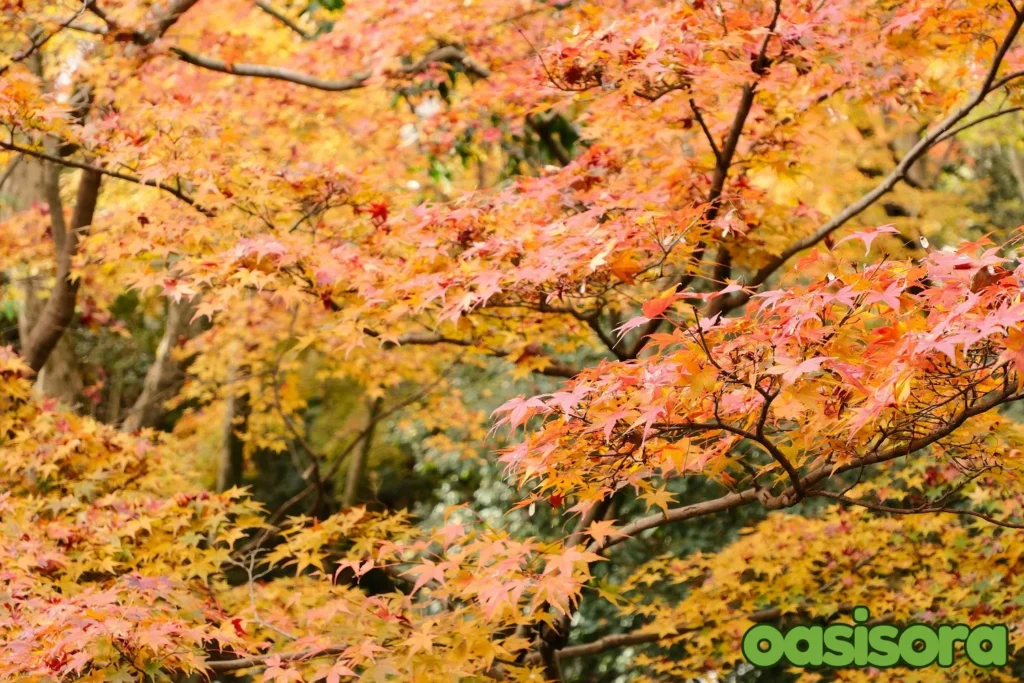
Japanese Maple
Japanese maples are a top pick for gardens due to their unique leaves. They are loved for the change in colors with the seasons, from summer greens and purples to fall reds, oranges, and purples.
Moreover, they shine in gardens, growing well under trees or by water, needing partial shade and space to grow.
2) Japanese Cherry
AKA Sakura Tree
| Latin name: | Prunus serrulata |
| Native to: | Japan, China, Korea, and Vietnam |
| Hardiness Zones: | USDA growing zones: 5-8 |
| Pros: | Stunning spring blooms attract bees & butterflies |
| Color varieties: | Pink, Red |
| Sun exposure: | Full |
| Soil needs: | Loamy, Well-Drained |
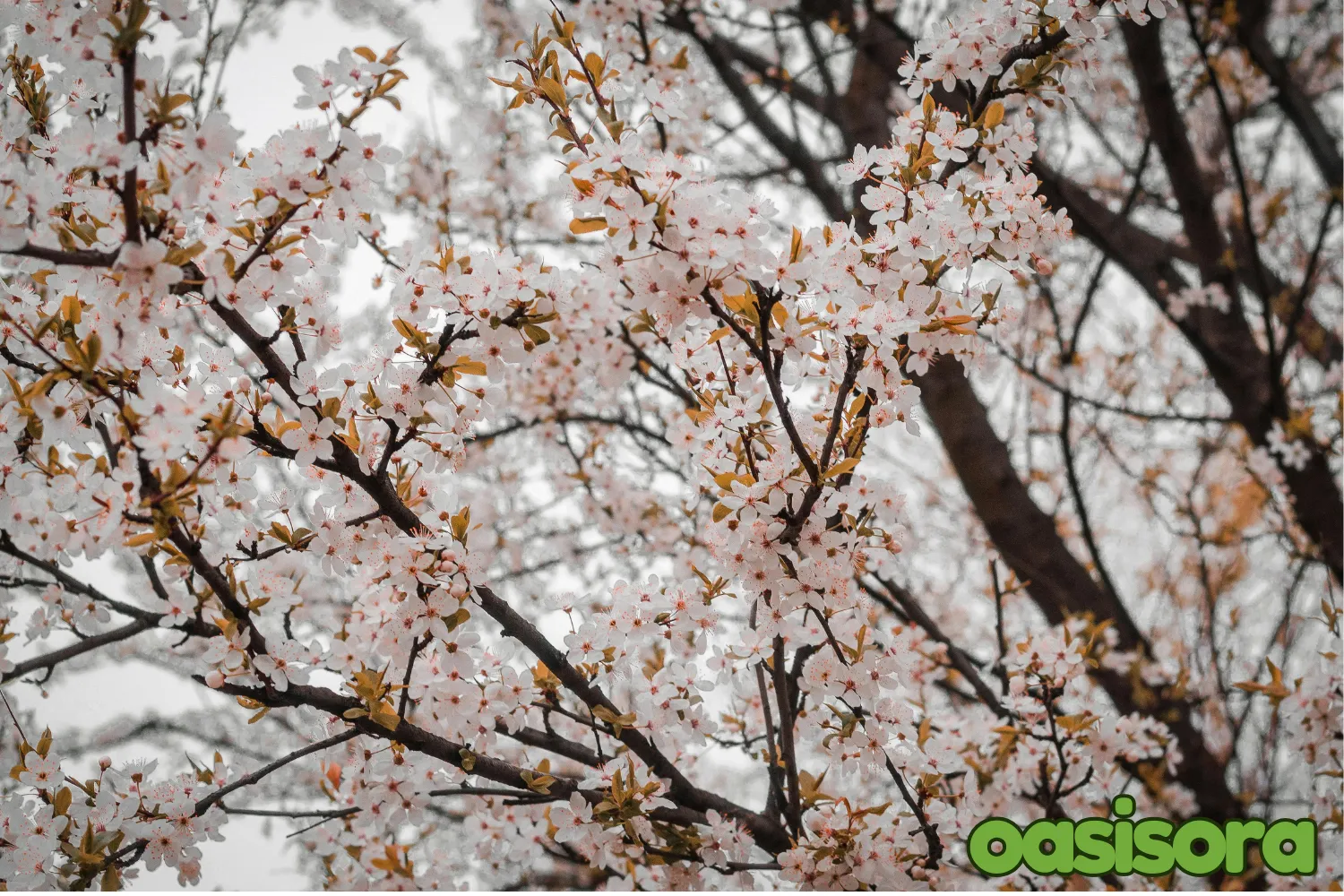
Japanese Cherry
Japanese Cherry trees shine in spring. These Japanese plants are often planted in big spaces or along streets and create beautiful shades.
Plus, they are perfect for framing paths or as a garden centerpiece. Cherry trees are great for zen gardens, symbolizing life’s fleeting beauty.
Furthermore, their brief, stunning blooms inspire global festivals. In Japanese, they are called sakura, representing life’s short, beautiful journey, a meaningful idea in Japanese culture.
3) Japanese Zelkova
AKA Japanese elm, keyaki, keaki
| Latin name: | Zelkova serrata |
| Native to: | Korea, Taiwan, Japan, Eastern China |
| Hardiness Zones | USDA growing zones: 5-9 |
| Pros: | Drought tolerant |
| Color varieties: | Yellow to bronze, Brick or rusty red |
| Sun exposure: | Full sun |
| Soil needs: | Wet, Properly Drained Soil |
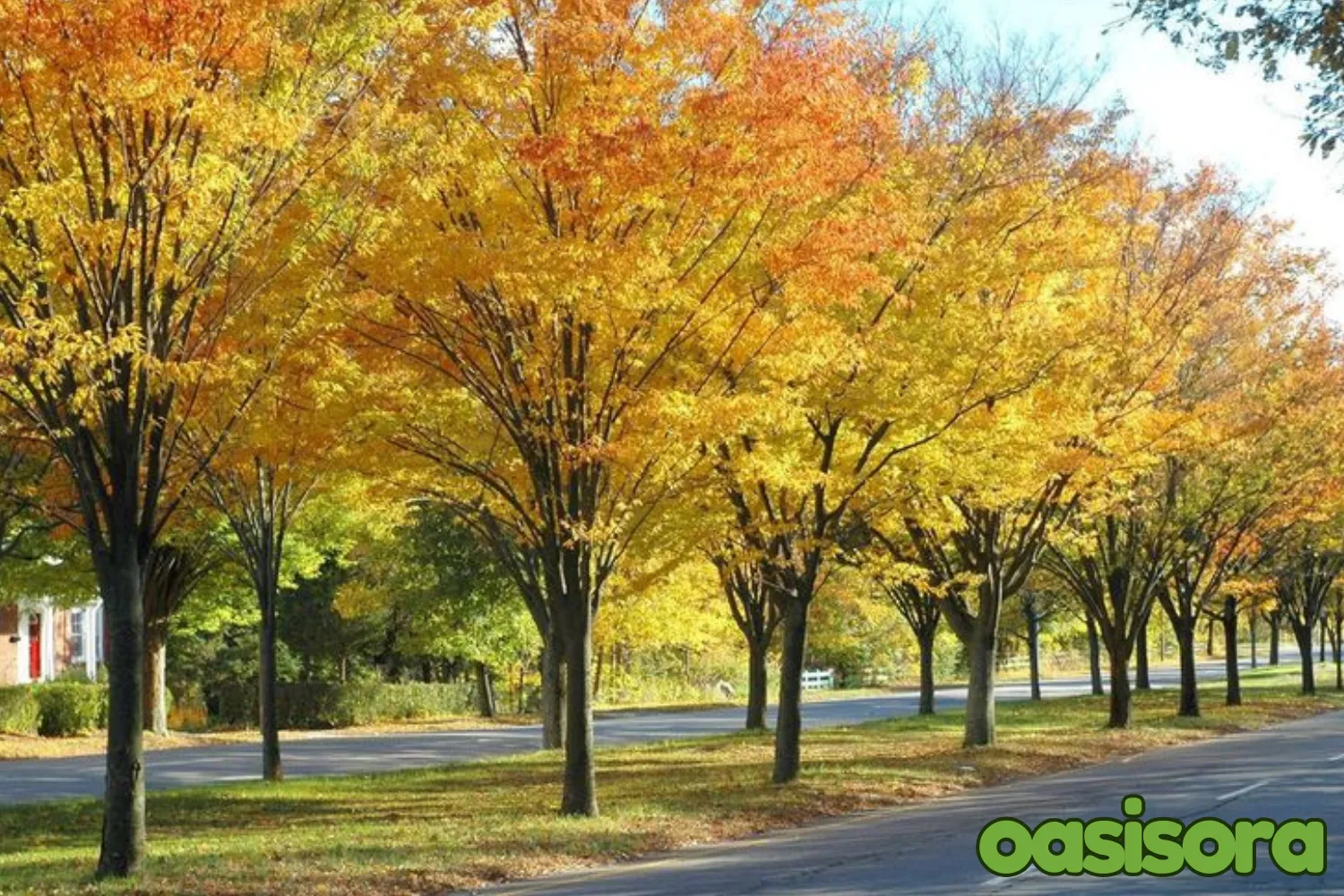
Japanese Zelkova
The Japanese Zelkova trees are loved as street trees. They are super hardy and have a beautiful shape.
Their branches form a vase shape, with lots of leaves on top. Usually, these trees bloom in the cities as they can endure the tough conditions and grow rapidly, providing shade and beauty.
Their leaves turn to amazing shades of orange, red, and yellow in the fall, and in winter, their gray bark peels to appear the orange underneath.
Japanese Zelkova trees look great all year round and last a long time, making them perfect for cities and gardens. Typically, they are a popular choice for their beauty and durability.
4) Japanese Black Pine (Pinus thunbergii)
AKA Black Pine
| Latin Name: | Pinus thunbergii |
| Native to: | Japan, Korea, and China |
| Hardiness Zones | USDA growing zones: 6-9 |
| Pros: | Unique shape, drought-tolerant, iconic bonsai tree |
| Color varieties: | Evergreen, dark green |
| Full Soil needs: | Well-draining, tolerant of poor soil |

Japanese Black Pine
Another great choice for a Japanese garden is the Japanese Black Pine (Pinus thunbergii). It is incredibly easy to maintain and has a really chic appearance. It can grow into a big, beautiful tree, but it looks most awesome in bonsai form.
It needs full sun, and its dark green needles remain green throughout the year. Typically, once it’s grown, it will need little water.
Deciduous Shrubs
Next, our second category of Japanese plants is Deciduous Shrubs:
5) Japanese Quince
AKA Maule’s Quince
| Latin name: | Chaenomeles japonica |
| Native to: | Japan |
| Hardiness Zones | USDA growing zones: 5-9 |
| Pros: | Spring blossoms |
| Color varieties: | Orange, pink, red, burgundy, white |
| Sun exposure: | Full/partial |
| Soil needs: | Moist, Well-Drained Loamy Soil |
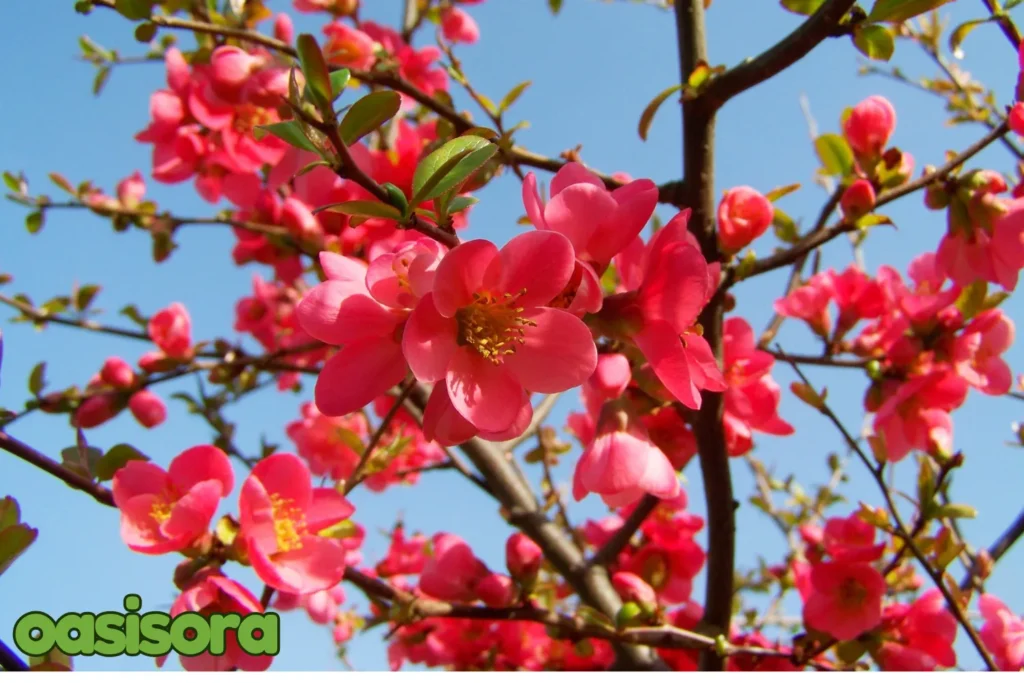
Japanese Quince
Japanese Quince is a strong, beautiful shrub. Before the leaves appear in the early spring, they produce bright orange, red, or pink flowers.
The thick, sharp branches of the shrub also serve as a barrier or fence in their way.
For gardeners who require little upkeep and constant beauty, the Japanese quince is an excellent choice. Its durability and minimal care needs make it a favorite.
So, enjoy beautiful flowers and functional protection in your garden with this amazing shrub.
6) Bigleaf Hydrangea
Also known as Mophead Hydrangea, French Hydrangea, Lace-Cap Cydrangea, and Hortensia
| Latin name: | Hydrangea macrophylla |
| Native to: | Japan |
| Hardiness Zones | USDA growing zones: 5-9 |
| Pros: | Huge flowers for prolonged summer and fall interest |
| Color varieties: | Blue, Pink |
| Sun exposure: | Full/partial sun |
| Soil needs: | Well-Drained Loamy Soil |
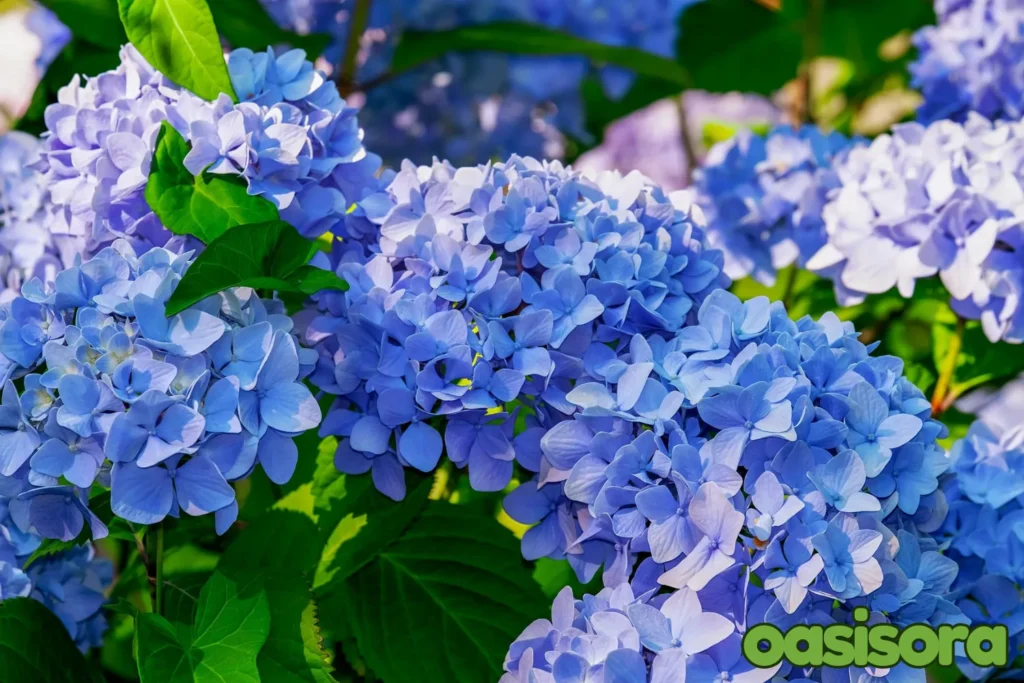
Bigleaf Hydrangea
One common garden plant is the Bigleaf hydrangea. It has lovely, big flowers that can thrive in either pink or blue, depending on the soil.
These shrubs add vibrant color to gardens all summer. They work well in borders, foundation plantings, or containers.
Moreover, these Japanese plants thrive in sun and shade. Their large blossoms and luxuriant leaves create a gorgeous show that is ideal for a small cottage garden.
Also, they are very flexible and simple to maintain. This is a supreme choice for you if you are looking for a romantic dash or a splash of color in your garden.
Evergreen Shrubs
7) Azalea
AKA Evergreen Azalea, Deciduous Azalea
| Latin name: | Rhododendron Spp |
| Native to: | Asia (the evergreen variety), North America (the deciduous variety) |
| Hardiness Zones | USDA growing zones: 4-10 (varies by species) |
| Pros: | Late spring-summer blooms |
| Color varieties: | Yellow, pink, orange, red, and white |
| Sun exposure: | Full/partial sun (varies by species) |
| Soil needs: | Moist, Well-Drained Soil |
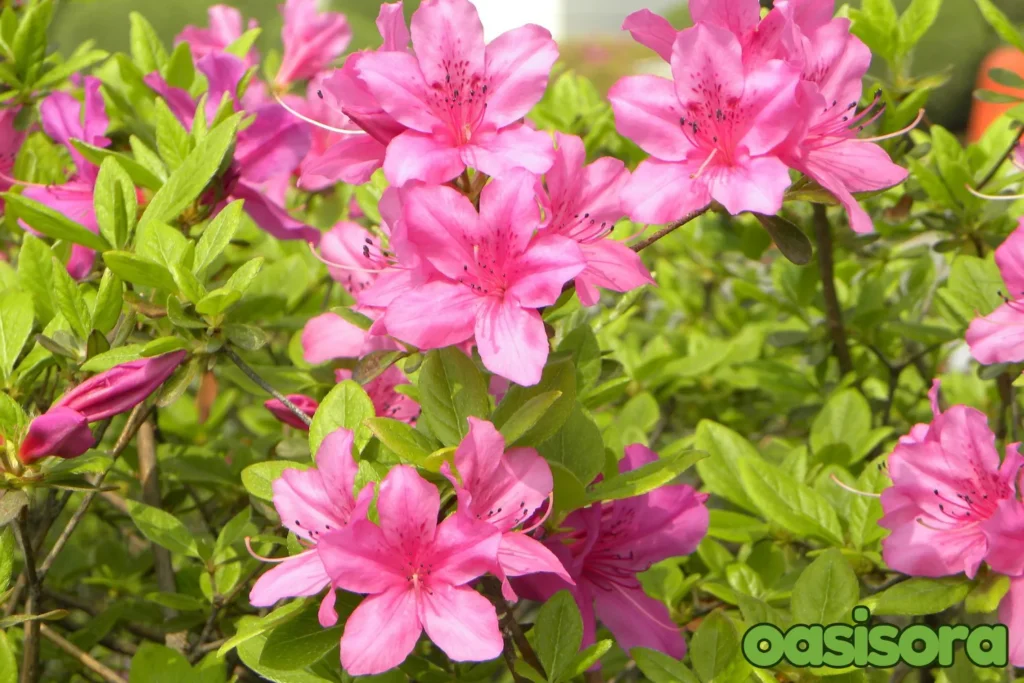
Azalea
Azaleas come in two types:
i. Evergreen
ii. Deciduous.
The Azaleas Evergreen Japanese plants have vibrant spring petals that range from white to deep red, and they hold their leaves throughout the year.
Deciduous azaleas produce larger flowers, but after a dramatic fall show, they shed their leaves in the autumn season. They handle harsh winters better.
Both types are great for borders, foundation plants, or solo features. Azaleas love Well-drained, acidic soil and some shade under trees or east-facing spots.
Plus, they thrive in these conditions, making them perfect for beautiful landscapes.
8) Japanese Camellia
AKA Common Camellia
| Latin name: | Camellia japonica |
| Native to: | China |
| Hardiness Zones | USDA growing zones: 7-9 |
| Pros: | Early and late season blossoms |
| Color varieties: | White, red, pink, purple |
| Sun exposure: | Acidic Soil |
| Soil needs: | Partial sun |
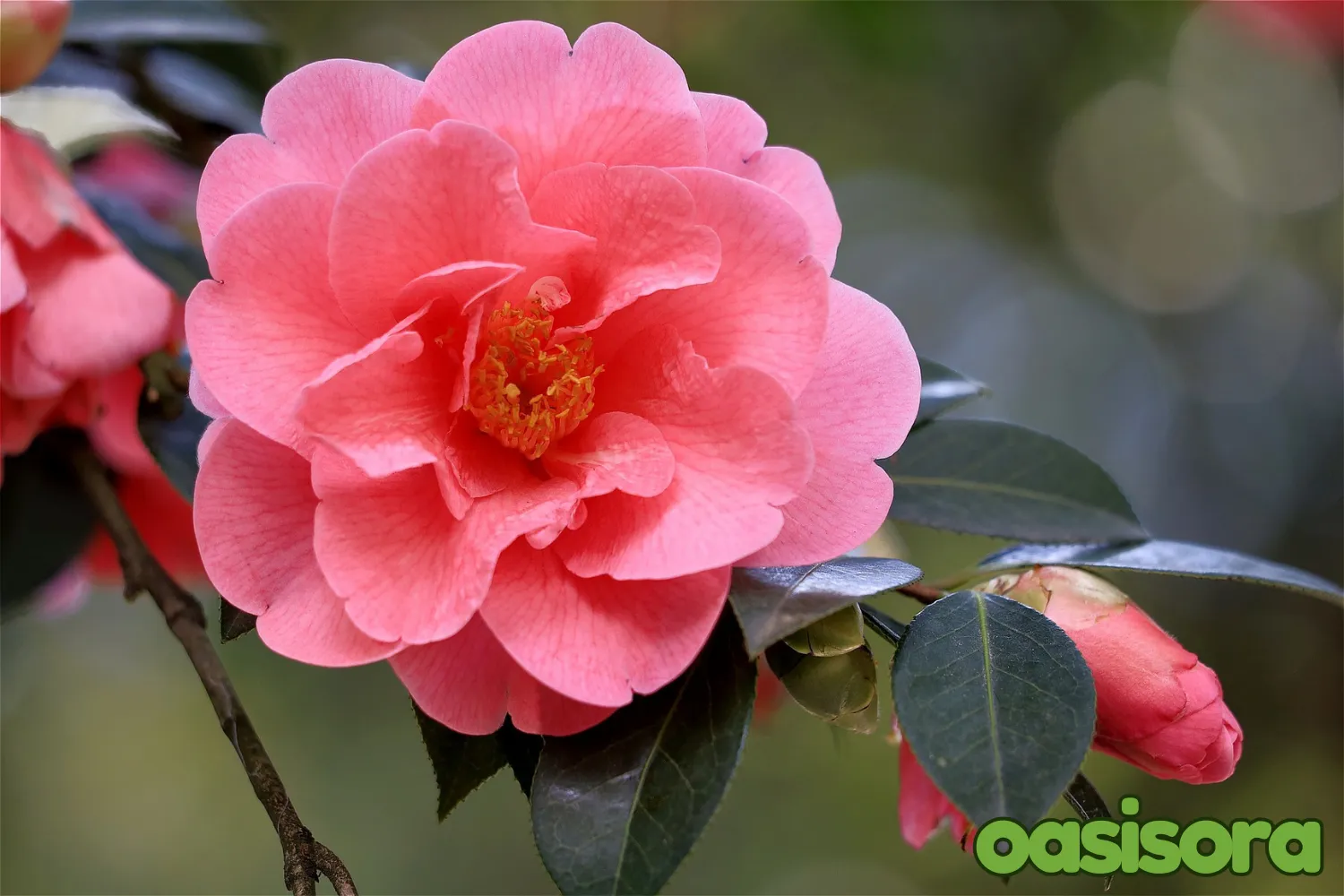
Japanese Camellia
Japanese Camellias have shiny leaves that look great in winter. They flowered red, pink, and white in the spring. They look great in the formal gardens and shaded areas.
Moreover, Camellias need acidic soil that drains well. They also prefer shade from strong afternoon sun to stay healthy and thrive.
9) Japanese Gardenia
AKA gardenia, cape jasmine
| Latin name: | Gardenia jasminoides |
| Native to: | Japan and Southern China |
| Hardiness Zones | USDA growing zones: 8-11 |
| Pros: | Fragrant blossoms |
| Color varieties: | Orange, red, and yellow |
| Sun exposure: | Full/Partial sun |
| Soil needs: | Well-Drained, Acidic Soil |
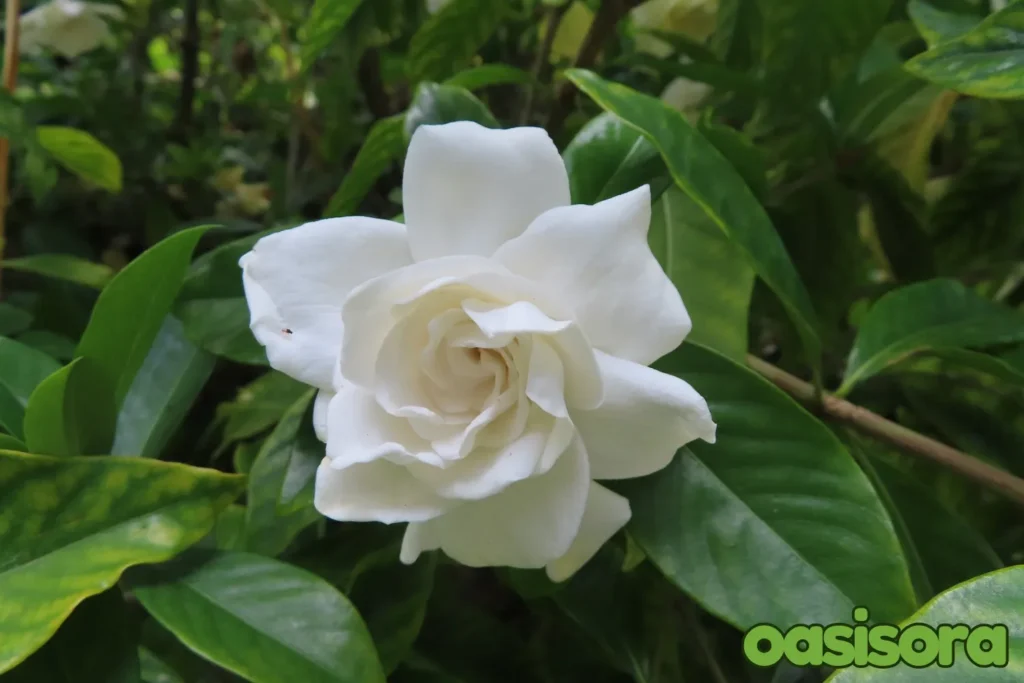
Japanese Gardenia
Love fragrances? Then try Japanese Gardenia in your garden. These Japanese plants can be used as individual plants or as borders or pots. Plus, they’re ideal for courtyards and walkways.
These plants need acidic or well-drained soil that’s sheltered from afternoon light. Furthermore, with good upkeep and care, they flourish and fill your garden with lovely fragrance.
10) Bamboo
The Phyllostachys genus contains more than 75 species of bamboo.
| Latin name: | Phyllostachys |
| Native to: | China |
| Hardiness Zones | USDA growing zones: 7-11 |
| Pros: | Late-summer and fall interest |
| Color varieties: | Blacks and goldens to light and dark greens. |
| Sun exposure: | Partial sun/shade |
| Soil needs: | Deep, Well-Drained Soil |
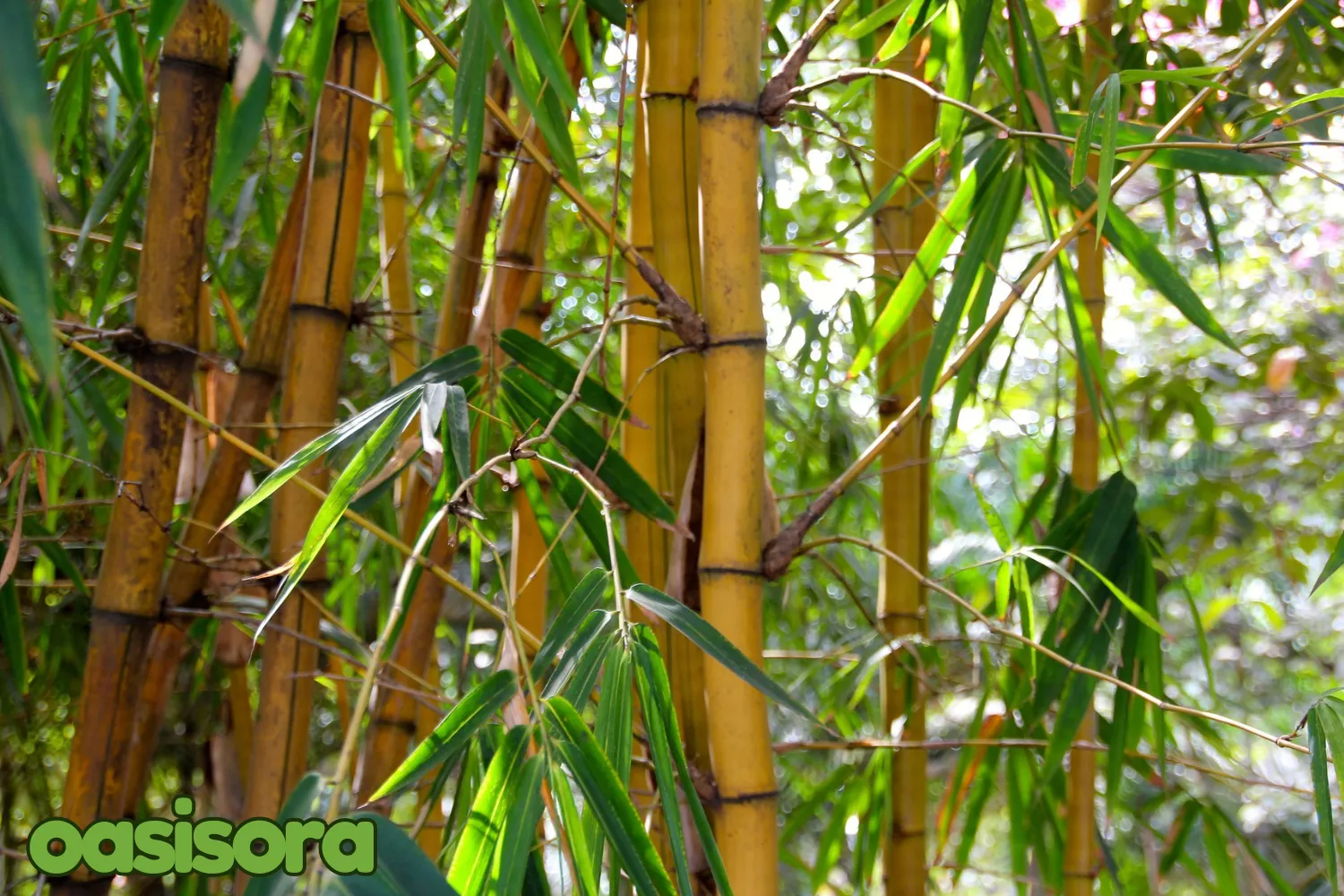
Bamboo
Bamboo Phyllostachys grows very fast and has tall, slender stems in shades of green, gold, and black. It’s great for creating natural barriers due to its thick growth.
Phyllostachys works well in large spaces or as a privacy screen. It grows in many soil types but likes moist, well-drained ground best. However, these Japanese plants can spread too much if not controlled.
To prevent this, use root barriers to keep it contained. Furthermore, Phyllostachys adds both appeal and value to any environment when given the right care.
11) Japanese Andromeda
AKA Japanese Pieris
| Latin name: | Pieris japonica |
| Native to: | Japan, eastern China, and Taiwan |
| Hardiness Zones | USDA growing zones: 5-8 |
| Pros: | Attracts bees and butterflies |
| Color varieties: | White, pink |
| Sun exposure: | Full/partial sun; acidic |
| Soil needs: | Well-drained soil |
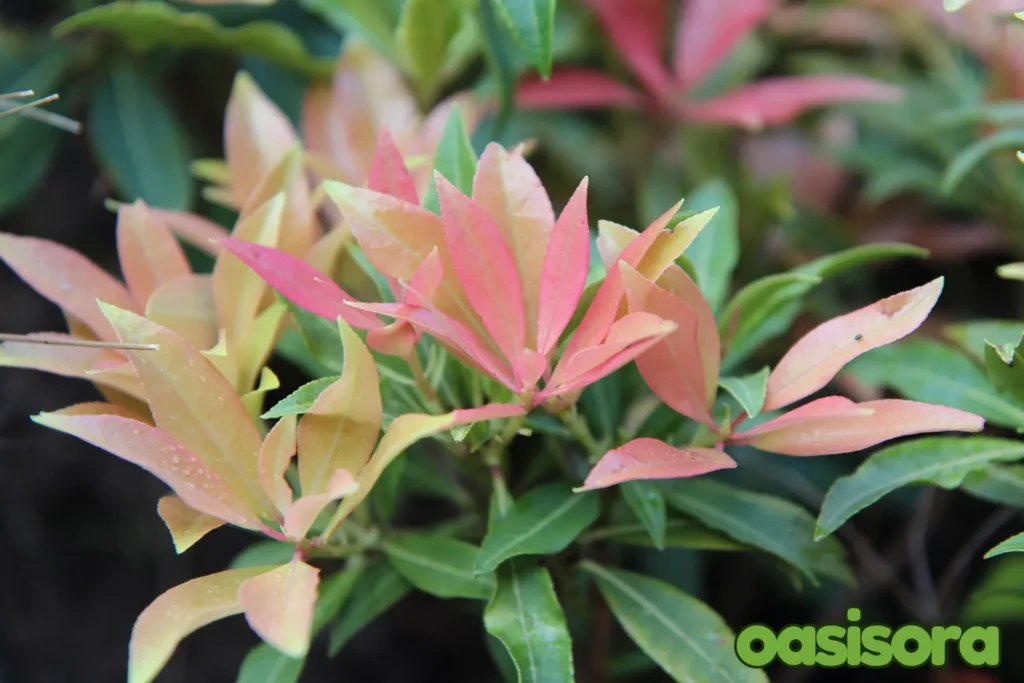
Japanese Andromeda
Japanese Andromeda is a beautiful Japanese plant that changes with the seasons. It produces beautiful bell-shaped flowers in shades of red, pink, or white in the early spring.
Before turning green, new leaves emerge in gorgeous red or copper hues. Plus, this plant looks great in shady areas or near homes.
However, remember it requires protection from intense afternoon sunlight to avoid damaging its leaves, and it thrives in acidic soil that drains well.
12) Japanese Skimmia
Japanese Skimmia has one main name, but there are many variations of its name depending on the specific type.
| Latin name: | Skimmia japonica |
| Native to: | Japan, China, and Southeast Asia |
| Hardiness Zones | USDA growing zones: 5-9 |
| Pros: | Fragrant, fall seasonal interest |
| Color varieties: | Creamy white |
| Sun exposure: | Partial sun/shade |
| Soil needs: | Well-Drained and Acidic Soil |
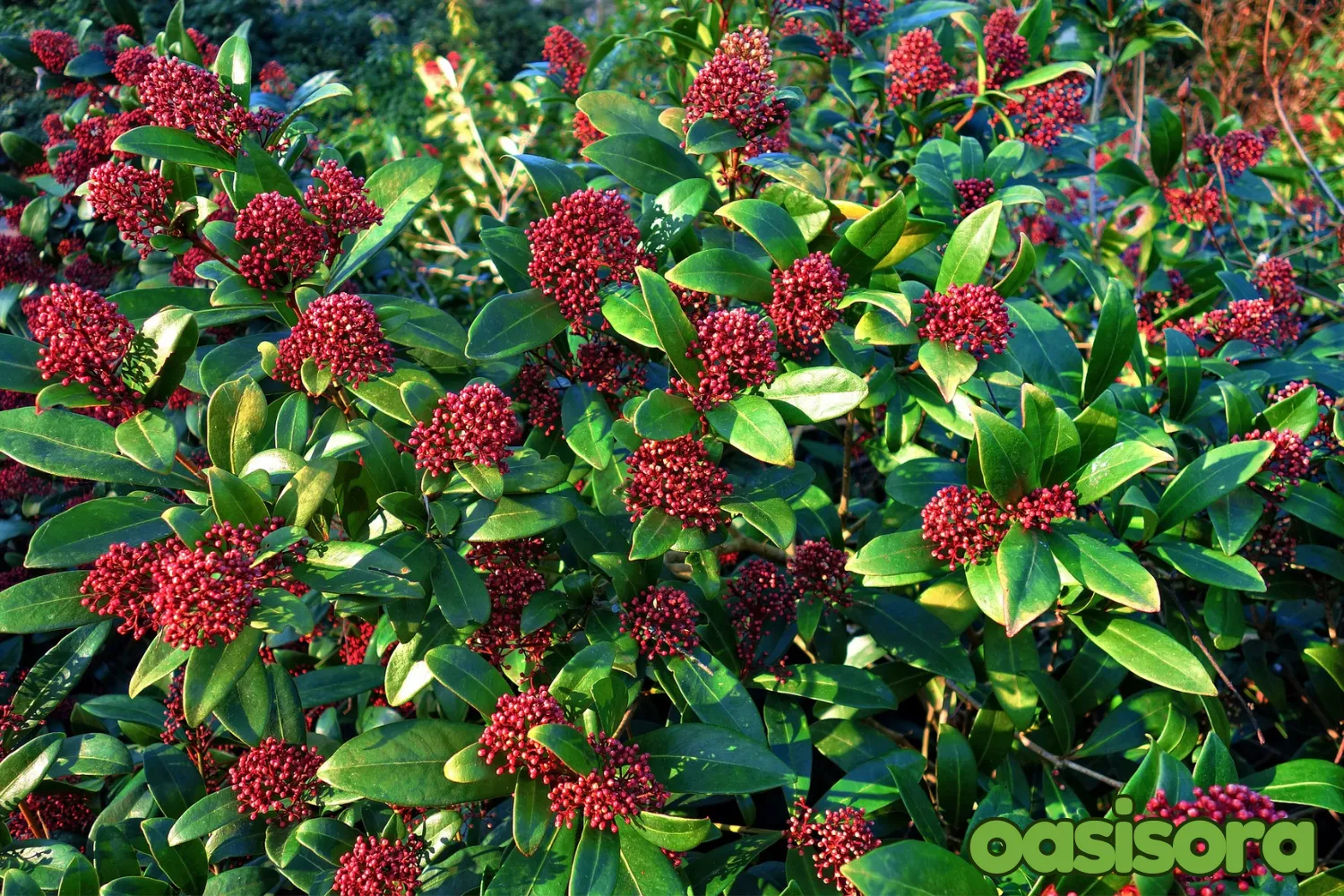
Japanese Skimmia
Skimmia shrubs have hardy and dark green leaves with fragrant white or pink blooms in the spring season. In the fall, it grows bright red berries that last till the winter.
Additionally, this shrub grows in areas with shade, beneath trees, or close to buildings. It prefers well-draining soil that is wet and slightly acidic.
Such types of Japanese plants are flawless for small gardens as they grow gently and remain modest in size.
Herbaceous Perennials
13) Japanese Windflower
AKA Buttercup
| Latin name: | Anemone hupehensis |
| Native to: | Asia |
| Hardiness Zones | USDA growing zones: 5-8 |
| Pros: | Mid-summer and fall interest |
| Color varieties: | Red, orange, yellow, blue, purple, white, pink |
| Sun exposure: | Full/partial sun |
| Soil needs: | Moist, Well-Drained Soil |
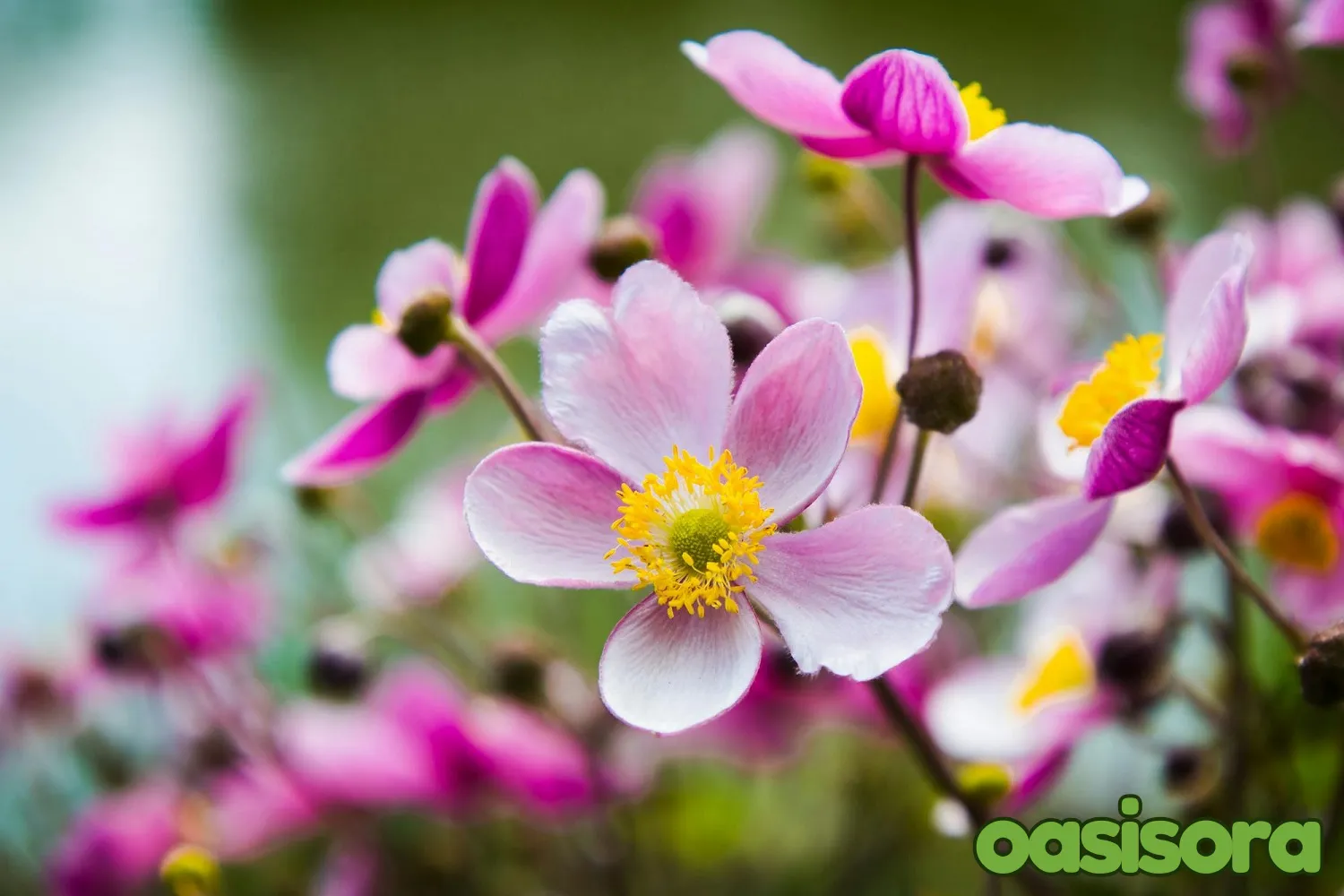
Japanese Windflower
A beautiful Japanese plant that blooms in late summer and fall is the Japanese Windflower.
Its tiny, airy, saucer-shaped flowers are either pink or white with golden centers. When other plants begin to fade, they give your garden a splash of color.
Plus, with minimal care, these gorgeous Japanese plants thrive and beautify your garden.
14) Japanese Chrysanthemum
AKA mums, chrysanths
| Latin name: | Chrysanthemum morifolium |
| Native to: | China |
| Hardiness Zones | USDA growing zones: 5-9 |
| Pros: | Splendid large blossoms |
| Color varieties: | Several colors and cultivars are available |
| Sun exposure: | Full/partial sun |
| Soil needs: | Well-drained soil |
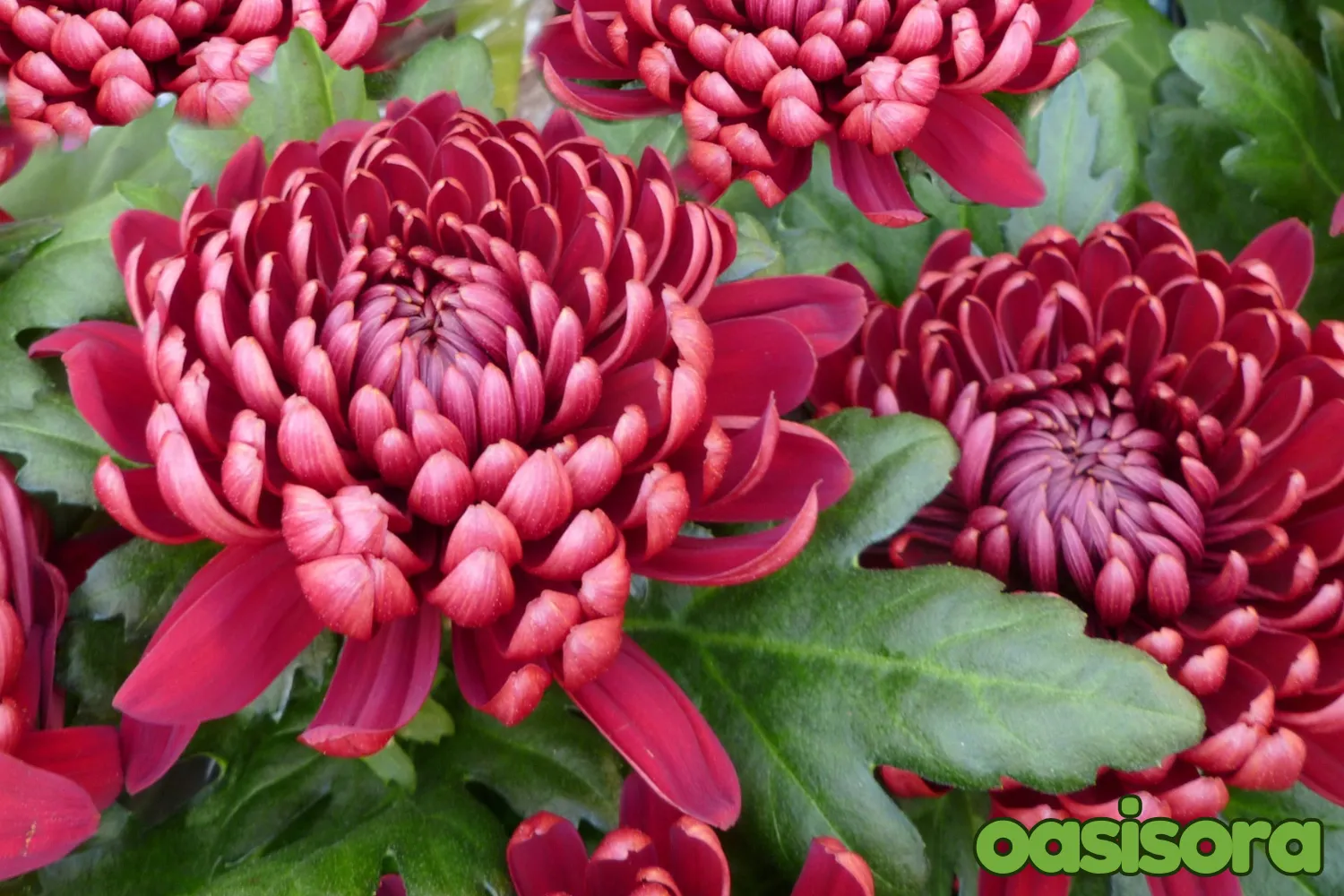
Japanese Chrysanthemum
The stunning, brilliant blooms of Japanese chrysanthemums are their most famous feature. Their pink, white, fiery red and yellow hues brighten autumn gardens.
The flowers have a variety of sizes and forms. Some are small and round, while others are large and fancy.
They work well for Japanese tea gardens, borders, and containers. Also, they require lots of sunlight and well-draining soil to develop.
Their late-season color makes them a popular choice. These Japanese plants are a timeless symbol of Japanese beauty and elegance.
15) Japanese Iris
AKA hanashōbu
| Latin name: | Iris ensata |
| Native to: | Japan, China, Korea, and Russia |
| Hardiness Zones | USDA growing zones: |
| Pros: | Attracts bees and butterflies |
| Color varieties: | Blue, pink, white |
| Sun exposure: | Full/partial sun |
| Soil needs: | Damp, Rich, and Acidic Soil |
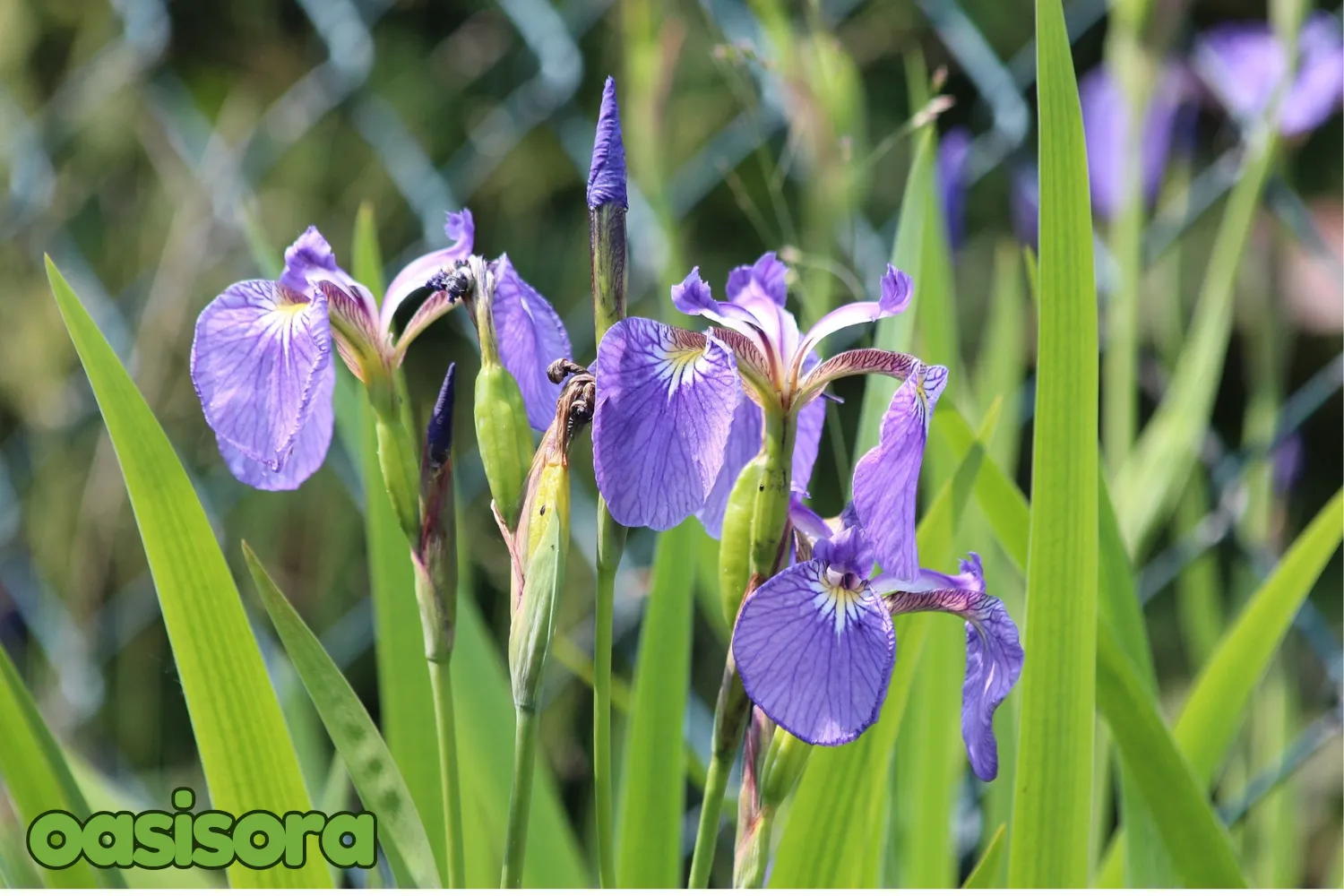
Japanese Iris
Japanese Iris is perfect for pond lovers! Its stunning flowers beautify gardens in summer.
These Japanese plants’ blooms are truly eye-catching, featuring large, flat petals in rich purples, blues, whites, and pinks.
Plus, Japanese Iris loves water-rich spots or moist garden areas with acidic soil.
It flourishes in bog gardens or by pond edges, where the soil stays consistently damp.
16) Japanese Lantern
AKA Strawberry Groundcherry, Bladder Cherry, Chinese Lantern, Winter Cherry, Alchechengi Berry, Klabuster Cherry
| Latin name: | Physalis alkekengi |
| Native to: | Northeast Asia, South, and Southern Europe |
| Hardiness Zones | USDA growing zones: 3-9 |
| Pros: | Mid-summer, fall, and winter interest |
| Color varieties: | Yellow |
| Sun exposure: | Full/partial sun |
| Soil needs: | Well-drained soil |
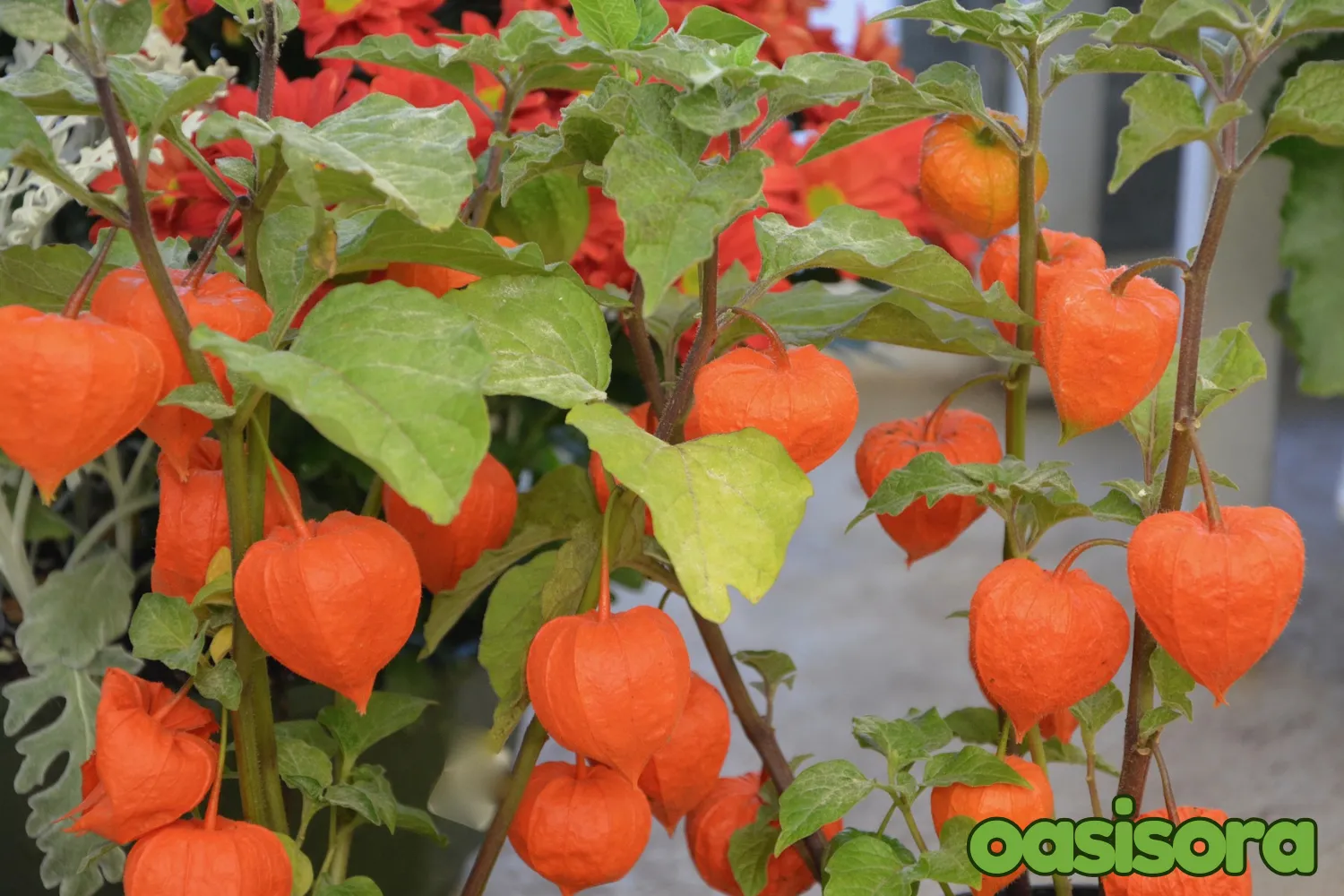
Japanese Lantern
Japanese Lantern plants are known for their bright orange to red paper-like coverings around small fruits, looking like mini lanterns.
They may thrive in a variety of light conditions, like full sun and partial shade, and grow well in soil that drains properly.
Plus, their ease of growth and low care requirements are two of their biggest benefits.
These Japanese plants are perfect for borders, adding a touch of elegance and fragrance to any garden bed.
17) Japanese Toad Lily
AKA Hairy Toad Lily, Toad Lily
| Latin name: | Tricyrtis hirta |
| Native to: | Japan |
| Hardiness Zones | USDA growing zones: 4-8 |
| Pros: | Late-summer and fall interest |
| Color varieties:x | Color varieties: Purple, blue, white, or pale yellow |
| Sun exposure: | Partial sun/shade |
| Soil needs: | Well-Drained, Loamy Soil |
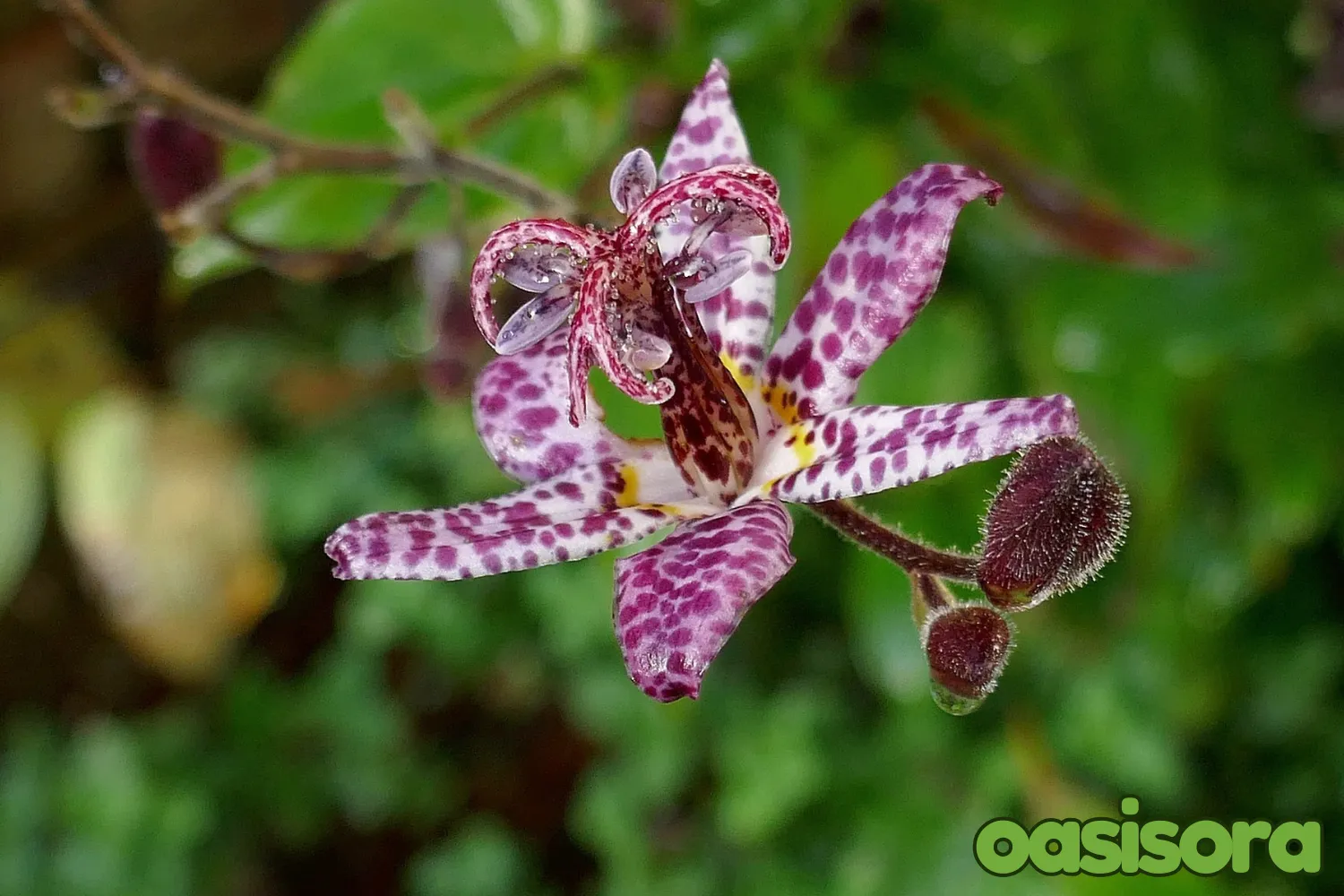
Japanese Toad Lily
Japanese Toad Lilies are special and beautiful flowers. They bloom late in the summer and early fall when other flowers start to fade. These flowers are unique because they:
· Have intricate patterns like orchids
· Come in white, pale yellow, purple, and blue colors
· Are small but eye-catching
Moreover, Toad Lilies grow best in:
· Shady areas
· Soil that’s moist and rich in nutrients
· Under trees or tall bushes where they get filtered sunlight
They are ideal for giving your garden’s shaded areas a splash of color.
18) Plantain Lily
AKA Hosta, Gibōshi
| Latin name: | Hosta |
| Native to: | China, Japan, eastern Russia, and Korea |
| Hardiness Zones | USDA growing zones: 3-8 |
| Pros: | Late-summer and fall interest |
| Color varieties: | Lavender |
| Sun exposure: | Partial sun/shade |
| Soil needs: | Rich, organic soil |
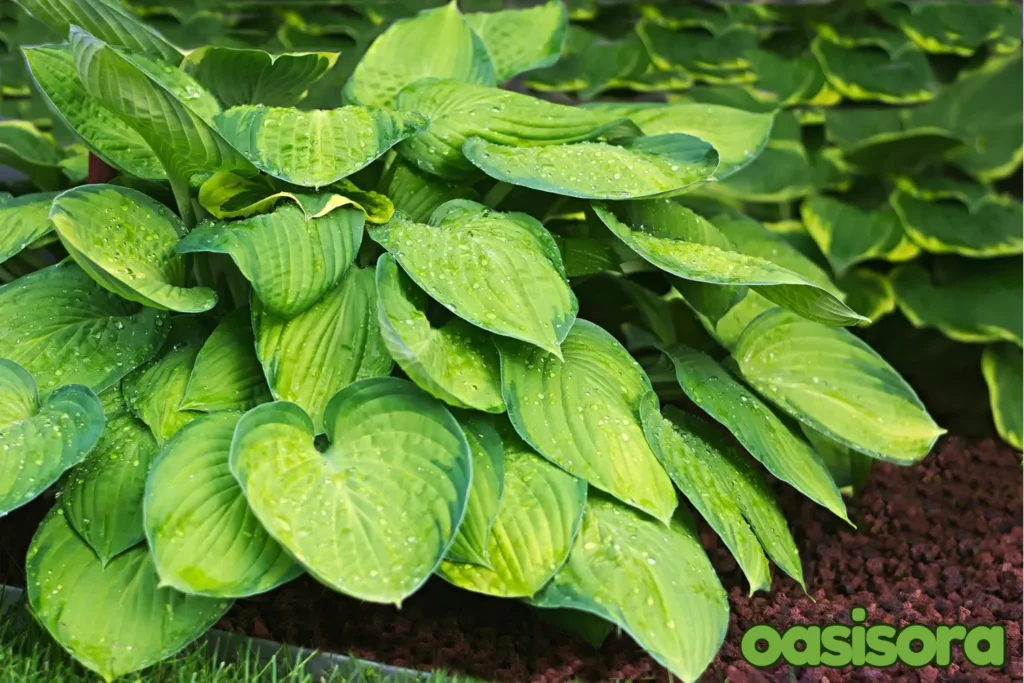
Plantain Lily
Plantain lilies are lovely and simple to grow, making them perfect for gardens containing shade. T
hese Japanese plants come in an extensive range of shapes, sizes, and hues, like blue, white, and green. These reasons explain their popularity:
· They cover the ground nicely and make beautiful borders.
· Their thick leaves stop weeds from growing.
· In summer, they grow pretty purple or white flowers.
These all features make Plantain Lilies a popular choice for shady areas.
19) Tiger Lily
AKA Oni Yuri
| Latin name: | Lilium lancifolium |
| Native to: | China, Japan, eastern Russia, and Korea |
| Hardiness Zones | USDA growing zones: 3-9 |
| Pros: | Attracts bees |
| Color varieties: | Orange, red, yellow, white, pink |
| Sun exposure: | Full/partial sun |
| Soil needs: | Organic or Well-Drained Soil |
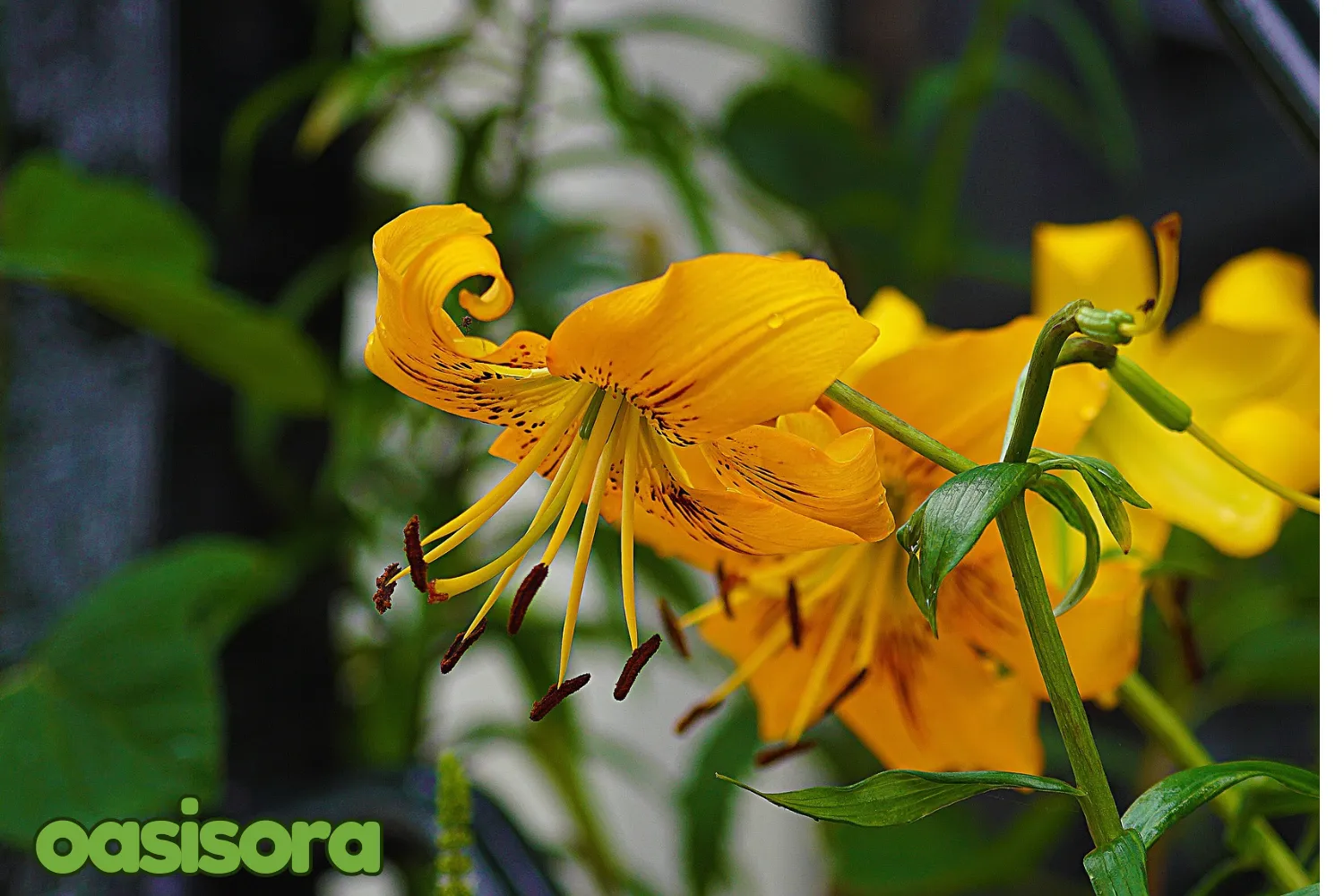
Tiger Lily
Tiger lilies are a lovely flower because of their vivid orange hue. Their petals are marked with black patterns that resemble the tigers’ fur. The flowers bend backward, making them look special.
These plants grow and prosper in either sunny or somewhat shaded areas, provided the soil drains enough.
These Japanese plants are hardy and need low maintenance. Over time, they can spread and grow more if they like where they are planted.
Grasses & Ferns
20) Japanese Painted Fern
AKA Black Lady Fern, Oriental Lady Fern
| Latin name: | Athyrium niponicum |
| Native to: | East Asia |
| Hardiness Zones | USDA growing zones: 3-8 |
| Pros: | Striking feather-like foliage with purple accents |
| Color varieties: | Gray-green, often flushed with burgundy |
| Sun exposure: | Partial sun/shade |
| Soil needs: | Well-Drained, Loamy Soil |
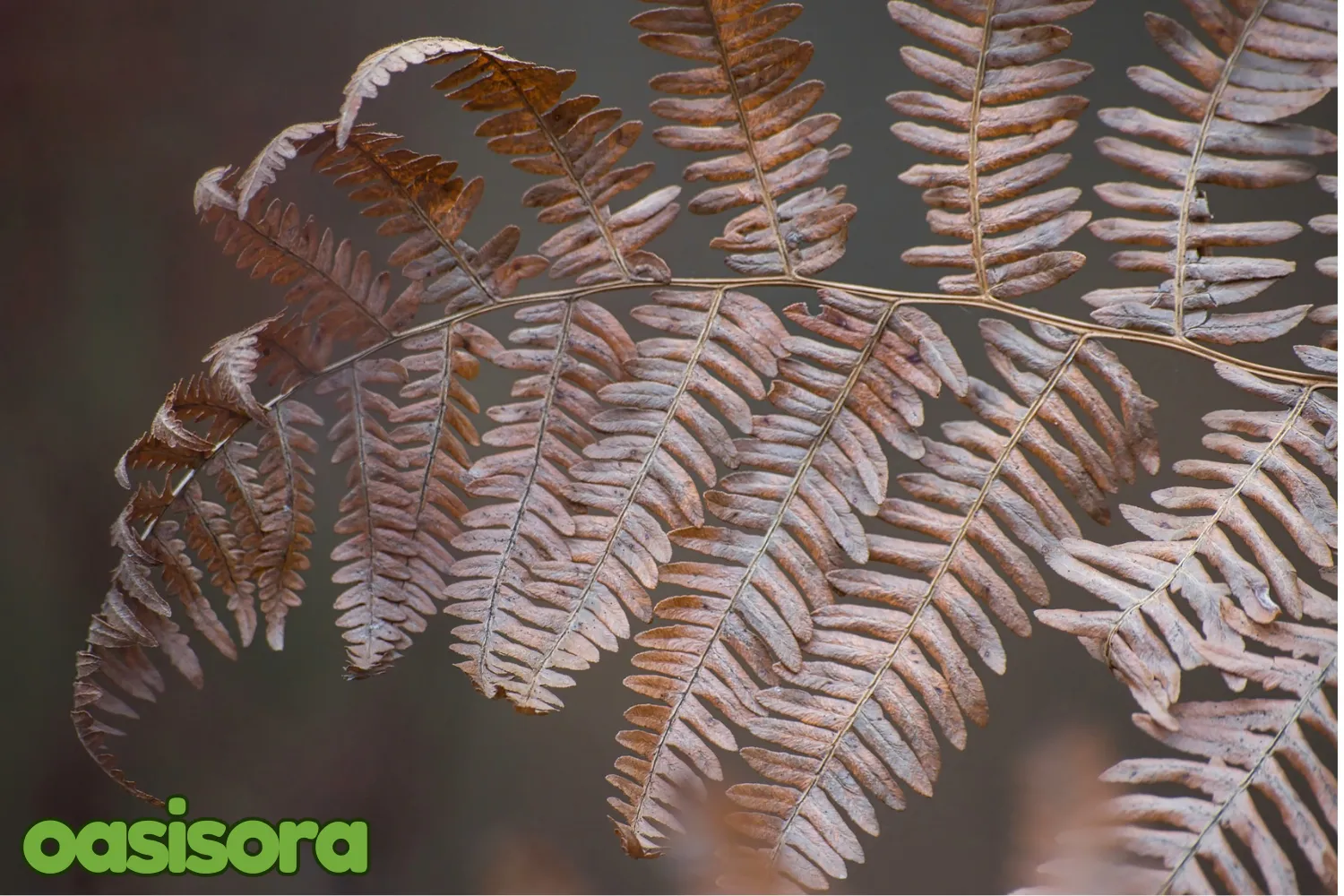
Japanese Painted Fern
The Japanese plants like Painted Ferns are known for their beautiful leaves. Their silver-gray leaves have blue and purple hints, making them visually striking.
To grow well, they need moist soil with plenty of organic matter. Moreover, they’re flawless for shaded gardens or with other plants that prefer shade.
They thrive in cooler, shaded spots where their colors stay vibrant.
21) Japanese Forest Grass
AKA Hakone Grass
| Latin name: | Hakonechloa macra |
| Native to: | Central Japan |
| Hardiness Zones | USDA growing zones: 5-9 |
| Pros: | Excellent ground cover |
| Color varieties: | Green, or boldly multi-colored in stripes of white, green, or yellow. |
| Sun exposure: | Full/partial sun, shade |
| Soil needs: | Moist, Well-Drained Soil |
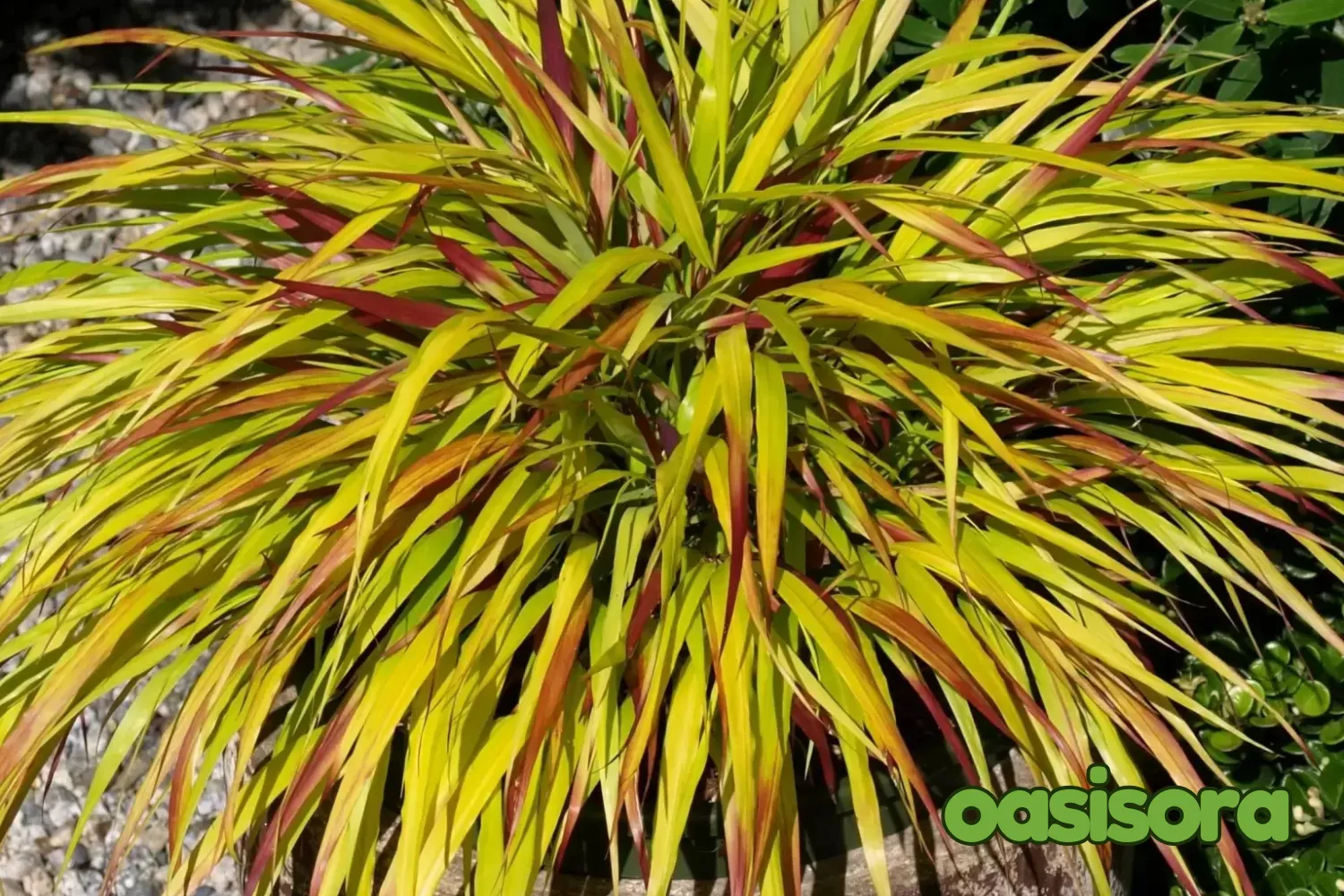
Japanese Forest Grass
Japanese Forest Grass is a beautiful, low-maintenance Japanese plant that blooms in places having shade. Golden yellow to vivid green are the colors of its delicate, curved leaves.
Additionally, this grass prefers moist yet well-draining soil. It’s ideal for growing in containers, beneath larger plants, or around the border of gardens.
Plus, this grass softly sways in the wind, giving your yard movement and texture.
22) Japanese Blood Grass
Also known as Cogon Grass, Kunai Grass
| Latin name: | Imperata cylindrica var. rubra |
| Native to: | Japan, Southeast Asia, and China |
| Hardiness Zones | USDA growing zones: 3-9 |
| Pros: | Summer and fall interest, attracts butterflies |
| Color varieties: | Burgundy or cranberry-red coloration |
| Sun exposure: | Full/partial sun |
| Soil needs: | Moist or Well-Drained Soil |
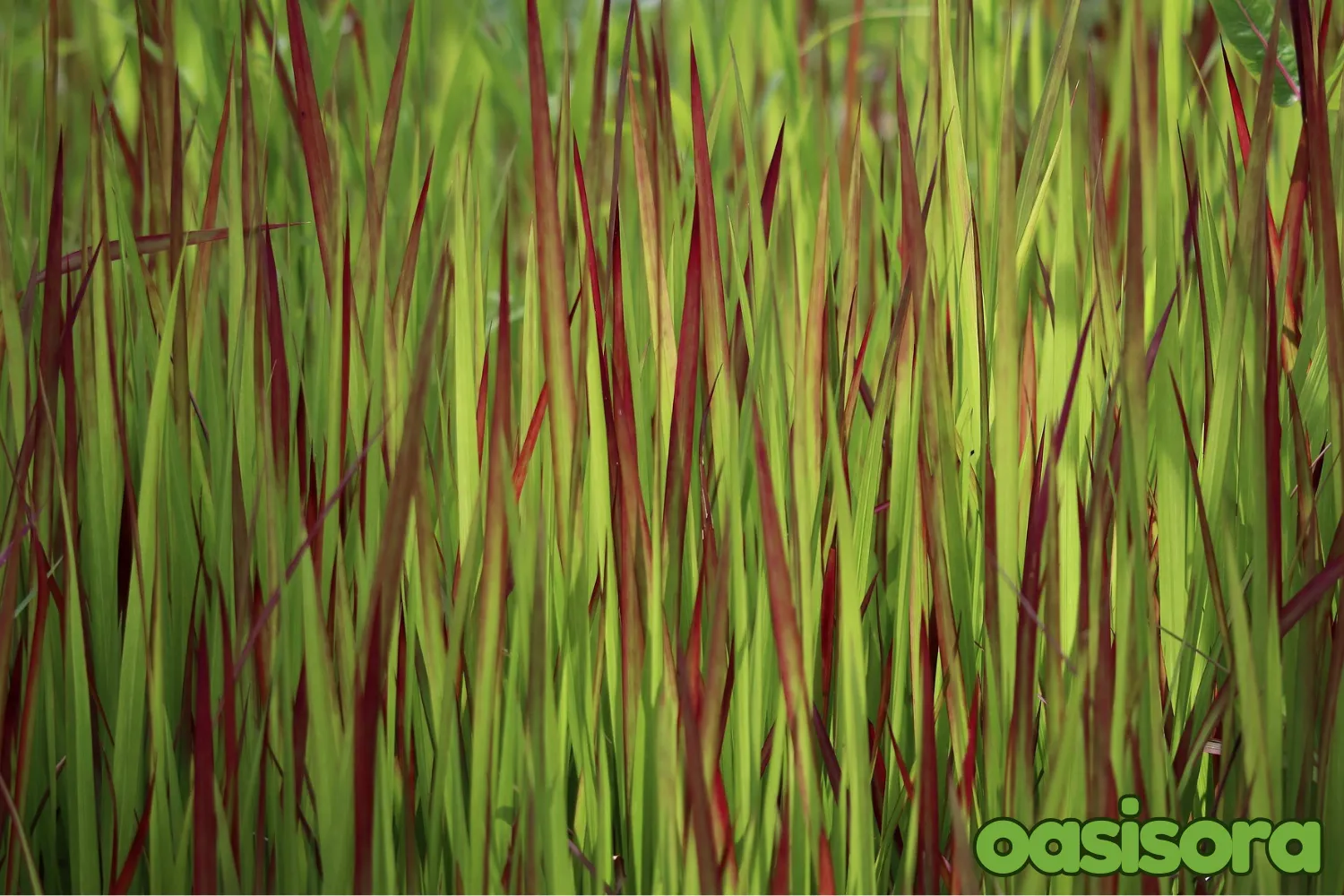
Japanese Blood Grass
The gorgeous Japanese plant known as Japanese Blood Grass has leaves that turn from green to a deep red color like flames.
This vibrant grass gives gardens a striking texture and energy. The crimson color increases with the changing of the seasons, adding a splash of color when other plants start to fade.
Additionally, it flourishes in areas with adequate drainage that are sunny to a bit shady. Moreover, this grass is ideal for ground cover, rock gardens, and borders.
To stop it from spreading too much, just make sure to apply a root barrier.
23) Mondo Grass
AKA Dwarf Lilyturf
| Latin name: | Ophiopogon japonicus |
| Native to: | India, Japan, Nepal, Vietnam, and China |
| Hardiness Zones | USDA growing zones: 7-10 |
| Pros: | Evergreen, extremely hardy |
| Color varieties: | White or light lilac |
| Sun exposure: | Partial sun/shade |
| Soil needs: | Moist or Well-Drained Soil |
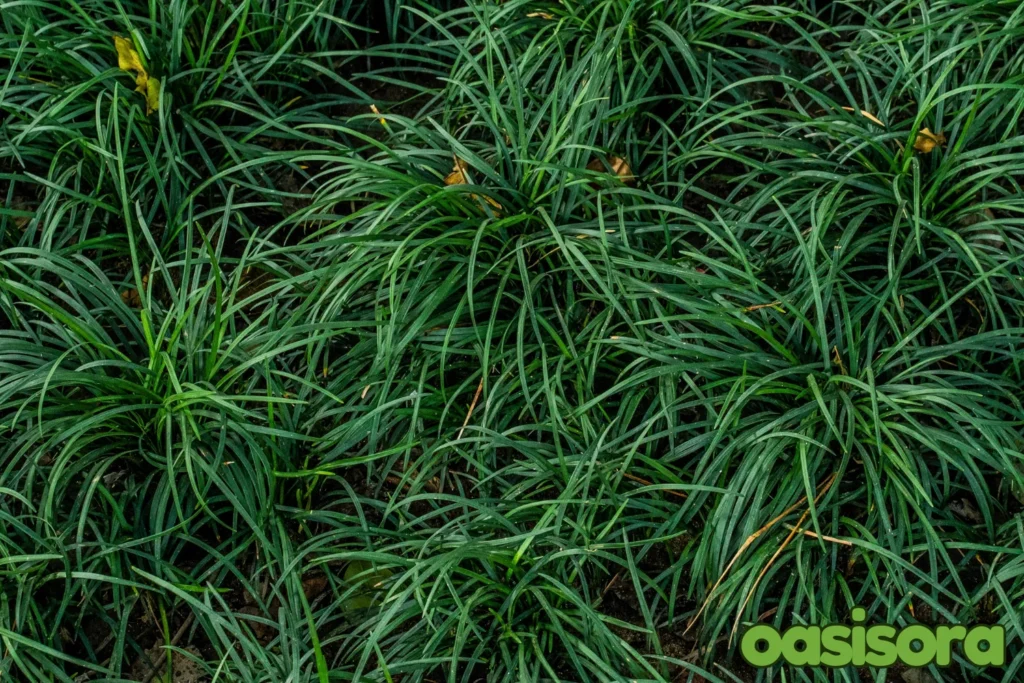
Mondo Grass
With grass-like leaves, Mondo grass is a lovely, low-maintenance planting. It remains green all year long and grows close to the ground. It’s perfect for:
· Filling gaps between stepping stones
· Bordering garden paths
· Shaded areas under trees
This excellent Japanese plant prefers:
· Partial to full shade
· Moist and Well-drained soil
Due to its easy care ability to tolerate urban pollution, and flexibility to an array of soil types, it’s an excellent option for many landscaping projects.
Vines & Groundcovers
24) Japanese Honeysuckle
AKA the Gold-and-Silver Honeysuckle, Chinese Honeysuckle, Hall’s Honeysuckle
| Latin name: | Lonicera japonica |
| Native to: | East Asia |
| Hardiness Zones | USDA growing zones: 4-9 |
| Pros: | Fragrant and appeals to hummingbirds or butterflies. |
| Color varieties: | Yellow-orange |
| Sun exposure: | Full/partial sun |
| Soil needs: | Moist, Loamy Soil |
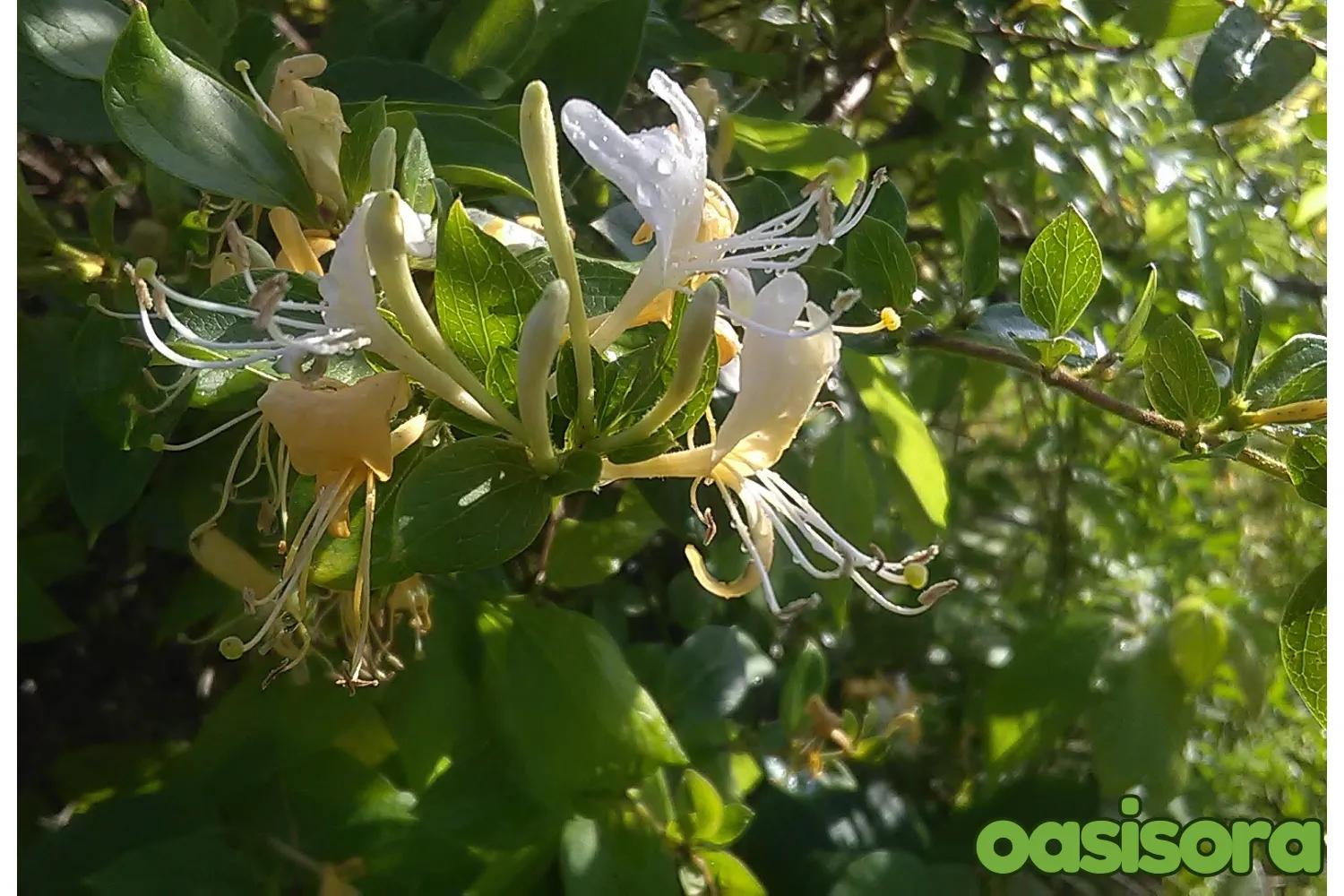
Japanese Honeysuckle
Japanese honeysuckle is a climbing shrub plant that grows speedily and has scented white or yellow buds.
It quickly covers fences and other structures, providing lots of leaves and fragrant blooms from spring to summer.
It grows in an assortment of soil kinds and thrives fine in areas that are sunny or slightly shaded.
But be careful! It can spread too much. If it’s a problem in your area, consider using a different type of Honeysuckle.
25) Japanese Spurge
AKA Carpet Box, Japanese Pachysandra, Pachysandra
| Latin name: | Pachysandra terminalis |
| Native to: | Japan, Korea, and China |
| Hardiness Zones | USDA growing zones: 4-8 |
| Pros: | Drought tolerant |
| Color varieties: | Glossy dark green |
| Sun exposure: | Full/partial sun |
| Soil needs: | Organic or Well-Drained Soil |
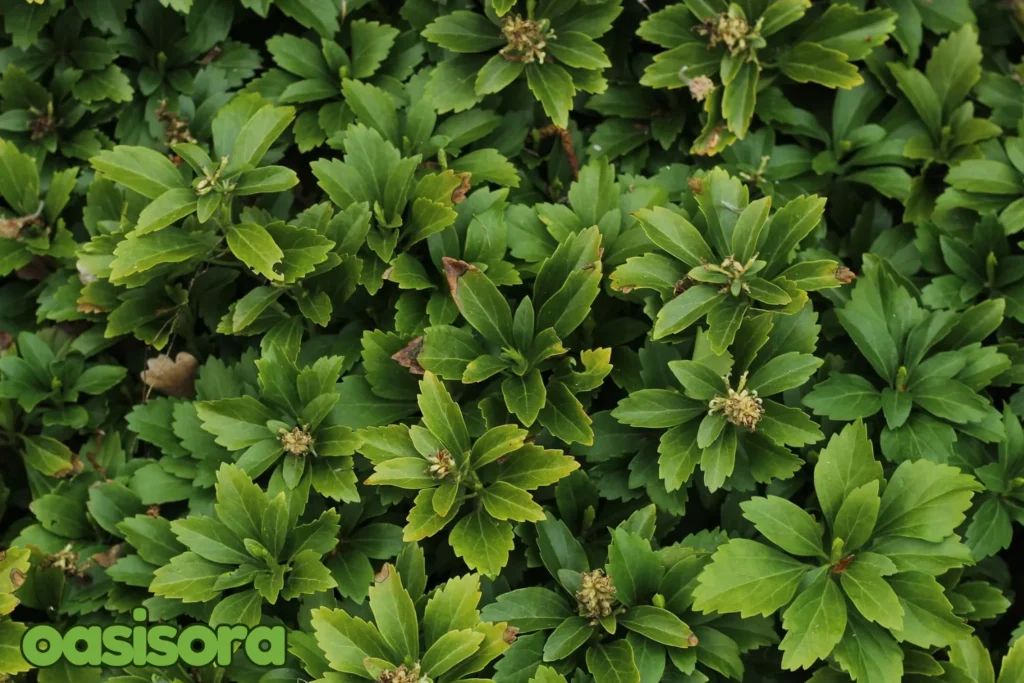
Japanese Spurge
Japanese Spurge is an easy-to-care- plant that can thrive in the shady areas in your yard.
It stays green year-round and grows close to the ground, with shiny leaves and tiny white flowers in the spring.
Furthermore, this Japanese plant is very flexible and can thrive in different types of soil.
It spreads slowly and helps keep weeds away, making it perfect for under trees or along paths.
26) Japanese Wisteria
AKA Wisteria
| Latin name: | Wisteria floribunda |
| Native to: | Japan, China, and Korea |
| Hardiness Zones | USDA growing zones: 5-9 |
| Pros: | Fragrant, attracts Butterflies |
| Color varieties: | Blue, White, Pink |
| Sun exposure: | Full/partial sun |
| Soil needs: | Acidic or Well-Drained Soil |
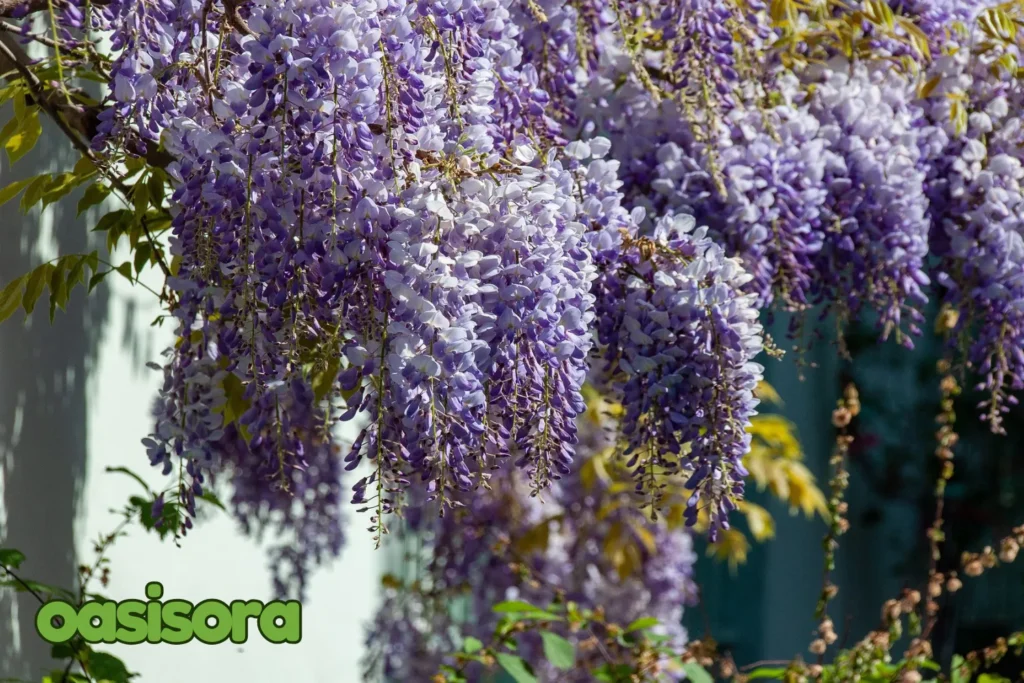
Japanese Wisteria
The Japanese Wisteria is a fabulous climbing Japanese plant that has fragrant, light purple or blue flowers in long, droopy bunches. These plants blossom wildly in the spring, producing an aesthetically pleasing and fragrant display. Plus, to grow this, you will need a strong grill or fence to support its heavy growth. It loves:
· Full sunshine to produce the most flowers
· Regular pruning to keep it under control and encourage blooming.
This plant is a real showstopper, but it needs some extra care.
Final Thoughts
Create your own peaceful and attractive garden with these 25 beautiful Japanese plants.
These plants are chosen for their stunning looks and special meanings in Japanese culture. Plus, they will turn your lawn into a calming landscape.
These plants are Japanese icons and perfect for a Zen garden or Japanese culture lovers.
Take care of them thoughtfully to make a gorgeous space where nature and people come together. Pick your favorites and start growing a peaceful colorful oasis today.
FAQs
1. What plant is most prevalent and famous in Japan?
The Japanese cherry or Sakura is one of the most eminent and prevalent plants In Japan.
2. In Japanese gardens, what kinds of plants are present?
Japanese gardens typically feature plants like:
Japanese Maple
Cherry Blossom
Bamboo
Bonsai
Moss
Zen Grass.
3. What is the name of the Japanese plant?
Cherry blossoms are know as national Japanese plant and its name is “Sakura”.
4. What plant is found in Japan?
Japan is home to various plants, including;
Japanese Iris
Japanese Lantern
Japanese Wisteria
Japanese Spurge
5. In Japan, what kind of plant is lucky?
The Japanese money tree is regarded as a lucky plant in Japan.
6. What is the Japan’s flower?
The Sakura is known as the Japan’s national flower.
7. What is the sacred plant in Japan?
Sakura is respected as a sacred plant In Japanese culture as it represents the short-term beauty of life.

11 thoughts on “26 Best Japanese Plants for a Stunning Garden”
Comments are closed.